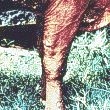
29 kb
The stable fly, Stomoxys calcitrans, resembles Musca domestica but has a stout, black proboscis which is used to pierce the skin and imbibe blood. It has a broader abdomen than the house fly and there is a checkerboard of dark spots on the dorsum of the abdomen. The stable fly has four longitudinal stripes on the thorax similar to those on the house fly.

65 kb
The wing of the stable fly shows the vein M1+2 only slightly curved forward towards vein R4+5.

69 kb
Stomoxys feeds on a wide variety of hosts including cattle, horses, pigs and humans. Repeated blood-meals are taken during the adult life and often a fly will feed on several hosts in one day.

135 kb
Following engorgement, both male and female stable flies become sluggish while digesting the blood meal. The favored resting sites are sunny fences, walls of houses and farm buildings, and other painted surfaces in general. When the flies are disturbed, they usually return to the same spot.

17 kb
Adults rest in exposed sunny sites on walls, fences and vegetation, usually close to animal housing. Stomoxys is easily mistaken for the common house fly, Musca domestica, or the false stable fly Muscina stabulans. The distinguishing features of Stomoxys are the piercing proboscis protruding forwards and the shorter and broader abdomen.

56 kb

56 kb

18 kb
The feeding flies have a bimodal diurnal pattern of feeding, locating hosts by responding to carbon dioxide and octenol. Individual Stomoxys calcitrans may feed more than once a day, bitting their host low down. They attack the ankles of humans, and the belly, lower body and limbs of domestic stock, particularly cattle and horses.